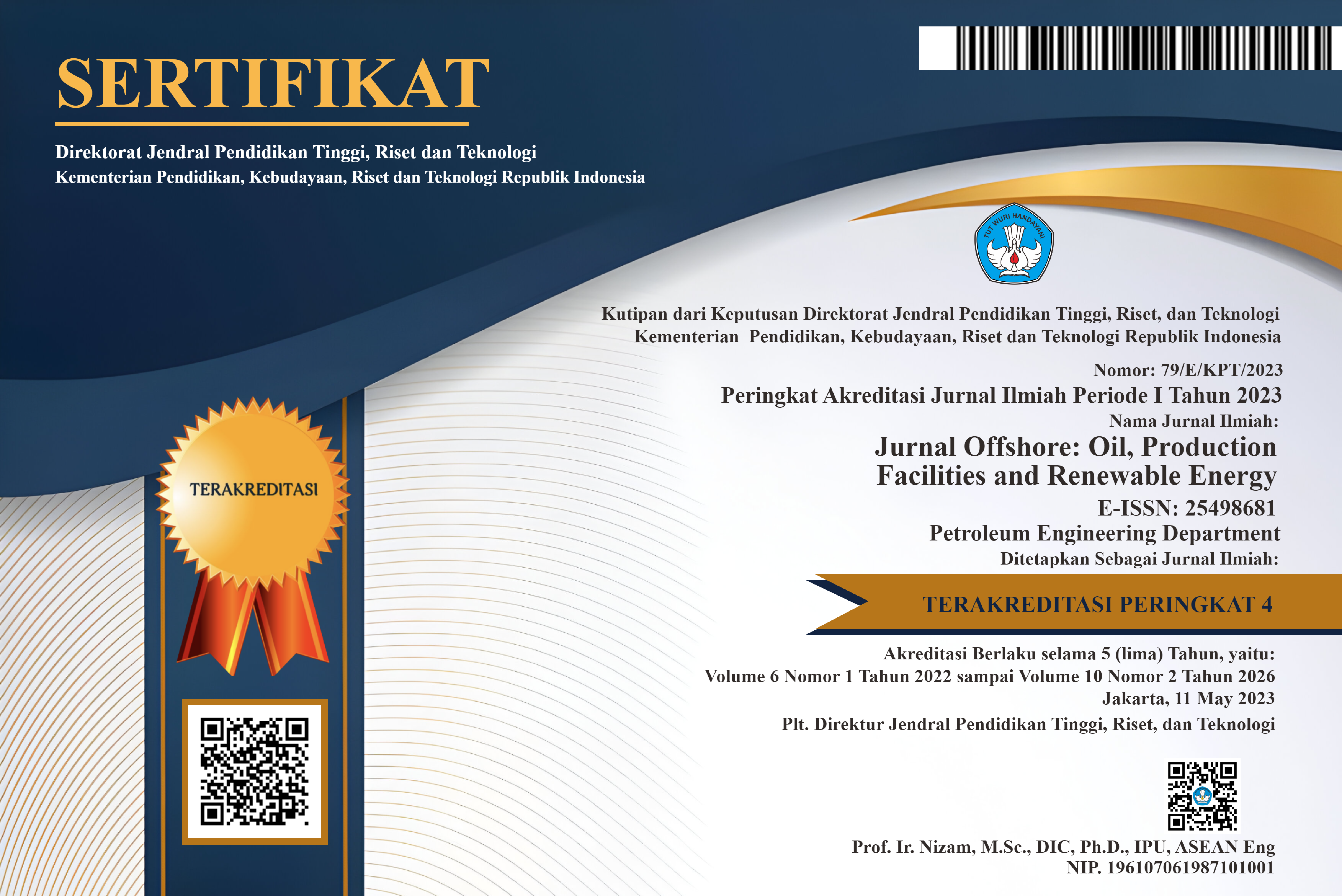Pengembangan Lapangan “Y” Menggunakan Simulasi Reservoir
DOI:
https://doi.org/10.30588/jo.v1i1.240Keywords:
OGIP, recovery factor, perforasi, perforationAbstract
Lapangan “Y” ditemukan melalui sumur pengeboran eksplorasi PMS 01 yang dibor pada 18 April 1980 dan diselesaikan pada 31 Juli 1980.Hal ini menyebabkan timbulnya pemikiran bagaimana strategi untuk mengembangkan lapangan guna meningkatkan recovery factor.Dalam menyelesaikan permasalahan ini dilakukan simulasi reservoir. Simulator yang digunakan adalah CMG-GEM yang dibuat oleh Computer Modelling Group Ltd., Calgary, Canada. Simulator tersebut adalah simulator jenis komposisional.Langkah awal dalam tahap simulasi adalah pengumpulan, persiapan, dan pengolahan data. Pengumpulan data meliputi data geologi, batuan, fluida, ekuilibrium dan data produksi. Proses inisialisasi merupakan tahapan setelah pemasukkan data yaitu proses pengkondisian model supaya selaras dengan kondisi awal reservoir yaitu dengan menyelaraskan OGIP hasil perhitungan simulator dengan perhitungan volumetrik. Proses inisialisasi menghasilkan harga OGIP simulasi sebesar 23.03 Bscf dan untuk perhitungan volumetrik adalah 23.07 Bcsf, hal ini menunjukan perbedaan kurang dari 1 %. Perbedaan yang sangat kecil tersebut memperlihatkan bahwa hasil simulasi sudah sangat memadai. Validasi data juga dilakukan dengan proses history matching (penyelarasan). Proses penyelarasan data produksi (laju produksi terhadap waktu dan kumulatif produksi terhadap waktu) dan tekanan menghasilkan kurva yang selaras.Peramalan perilaku produksi reservoir dilakukan dengan membuat beberapa skenario produksi. Ada usulan tiga skenario, yaitu Skenario A, reservoir diproduksikan oleh satu sumur PMS 01 dengan membuka perforasi pada zona 12 dan zona 15 (base case), Skenario B, reservoir diproduksikan oleh PMS 01 dengan membuka perforasi pada zona 12, zona 15 dan zona 16. Skenario C, reservoir diproduksikan oleh dua sumur yaitu sumur PMS 01 (zona 12, zona 15 dan zona16) dan sumur PMS 03 (zona 12, zona 15 dan zona 16). Berdasarkan skenario yang dilakukan diperoleh kumulatif produksi terbesar pada skenario C sebesar 16.2 Bscf atau dengan recovery factor sebesar 70.22 %.
The "Y" field was discovered through an exploration drilling well PMS 01 which was drilled on April 18, 1980 and completed on July 31, 1980. This led to the emergence of ideas on how to develop a field to improve recovery factors. In solving this problem reservoir simulations were carried out. The simulator used is the CMG-GEM made by Computer Modeling Group Ltd., Calgary, Canada. The simulator is a compositional type simulator. The first step in the simulation stage is data collection, preparation, and processing. Data collection includes geological, rock, fluid, equilibrium and production data. The initialization process is the stage after data entry, namely the model conditioning process so that it is aligned with the initial reservoir conditions by aligning the OGIP results of the simulator calculation with the volumetric calculation. The initialization process produces a simulation OGIP price of 23.03 Bscf and for volumetric calculations is 23.07 Bcsf, this shows a difference of less than 1%. The small difference shows that the simulation results are very adequate. Data validation is also carried out with the history matching process. The process of aligning production data (production rate with respect to time and cumulative production with respect to time) and pressure produces a harmonious curve. Forecasting of reservoir production behavior is carried out by creating several production scenarios. There are three proposed scenarios, namely Scenario A, the reservoir is produced by one well PMS 01 by opening perforation in zone 12 and zone 15 (base case), Scenario B, the reservoir is produced by PMS 01 by opening the perforation in zone 12, zone 15 and zone 16 Scenario C, the reservoir is produced by two wells namely PMS 01 wells (zone 12, zone 15 and zone16) and PMS 03 wells (zone 12, zone 15 and zone 16). Based on the scenario, the largest cumulative production obtained in scenario C is 16.2 Bscf or with a recovery factor of 70.22%.
References
Ahmed, Tarek H., “HydrocarbonPhase Behavior” Gilf Publishing Company, Houston, Texas, 1989.
Amyx, J.,W Bass, DW. Jr., Whiting, R, L., “Petroleum Reservoir Engineering Physical Properties”, Mc Graw Hill Books Company, New York, Toronto, London, 1660.
Crichlow, H..B, “Modern Reservoir Engineering A Simulation Approach”, Prentice-Hall, Inc., Englewood Cliffs, New Jersey, 1977.
Craf, B.C ang Hawkins, M.. F. “Applied Petroleum Reservoir Engineering “Prentice-Hall, Inc., Englewood Cliffs, New Jersey, 1959.
Craig, J.R., F.F., Geffen, T.M. Morse R.A. “Enhanced Oil Recovery”, SPE Textbook Series Volume 6, Texas,1998.
Koesumadinata, R.P.,Geologi Minyak dan Gas Bumi. Jilid I dan II, Edisi Kedua, Jurusan Teknik Perminyakan ITB, Bandung,1980.
Lee, W.J., “Applied Reservoir Simulation Industry School” Simulation Course Handbook, Texas A&M University, June, 1995.
Mattax, C.C and Dalton, R.L., “Reservoir Simulation” Society of Petroleum Engineers Inc, Texas, 1990.
……………., “Advance Compositional Reservoir Simulation Version 2006” GEM User Guide Computer Modelling Group. Ltd.,2006.
……………., “TAC Ranya Energi Pamanukan Selatan”, 2006.
……………., “Practical Reservoir Simulation” Chevron Extended Aplication Reservoir Simulator User Handbook, Chevron Tech, Co., 1996.
Downloads
Published
How to Cite
Issue
Section
License
Authors retain copyright and grant the Jurnal Offshore right of first publication with the work simultaneously licensed under a Creative Commons Attribution 4.0 International License that allows others to share (copy and redistribute the material in any medium or format) and adapt (remix, transform, and build upon the material) the work for any purpose, even commercially with an acknowledgement of the work's authorship and initial publication in Jurnal Offshore. Authors are able to enter into separate, additional contractual arrangements for the non-exclusive distribution of the journal's published version of the work (e.g., post it to an institutional repository or publish it in a book), with an acknowledgement of its initial publication in Jurnal Offshore. Authors are permitted and encouraged to post their work online (e.g., in institutional repositories or on their website) prior to and during the submission process, as it can lead to productive exchanges, as well as earlier and greater citation of published work (See The Effect of Open Access).
















